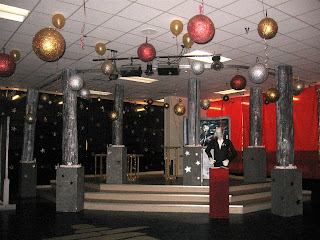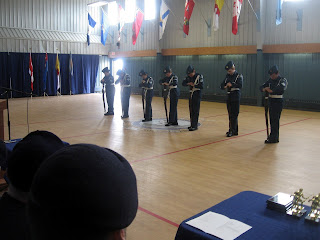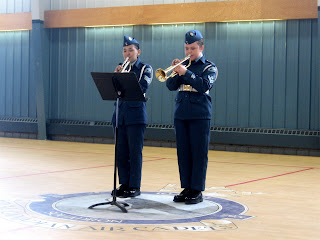The
last two weeks were about administering and marking final exams. My Grade 9 guitarists had it easy; they were
only required to play a piece or a few famous guitar riffs (melodies). For extra marks, several students performed in
front of the class. The Grade 10s had
the most work: a theory test and a performance test. My Grade 11s had to write a two hour English
exam in two parts. The first part was an
essay based on the film Stand &
Deliver. The second part dealt with
short stories, poetry, and advertising in media. Most were able to complete the exam in 90
minutes. And finally, my senior
musicians (Grade 11 & 12) just had a performance test to complete. The performance tests analysed my junior
& senior students' abilities to play scales, selected repertoire, and clap
rhythms. My junior percussionists also
had to perform several rudiments (the percussion equivalent to scales).
When all exams are completed, the
teacher is presented with the important task of marking them fairly and adding
the mark to the student's overall grade.
Calculating a student's overall grade is a task that requires patience,
objectivity, and math. I spent quite a
lot of time going through the calculations and making sure that they were
correct. The last step is to enter all
the marks into the school's computer database.
An optional step that I followed is writing a comment in the Comments
Section for each student.
After exams, the school year was
pretty much over for students. A sports
day was held on June 14, and many students & teachers ventured up to the
new hockey arena to play soccer. The
rinks had been dried and replaced with green astro-turf. From what I heard, the competition between
teachers & students was intense. I
stayed at the high school to finish inputting my final marks into the school
database. The topic of sports came up
again on June 18 in the manner of a sports/athletics award ceremony. Chosen students received awards for being the
best players in soccer, basketball, badminton, and weight lifting.
Over the summer months, Inuksuk High
School will be one big construction zone.
The main office, teacher's lounge, cafeteria, library, main foyer,
several classrooms, and four main stairwells are being renovated. I think the outside structure is being
repainted as well. In order to prepare
for this, staff have been moving resources and equipment to the areas that will
remain untouched. I made sure to wear
plain clothing rather than my formal attire.
You name it, we moved it: tables, chairs, papers, books, posters,
photocopiers, etc. I think I may have
added some muscle to my arms. The
selected rooms now look barren & empty.
When I come back in late August, the school may look like a completely
different building (more on that later).
To celebrate the end of the school
year, a year-end staff party was held at a pub called The Elks on Saturday
(June 16). The event was organized as a
pot luck and many teachers brought a variety of snacks, dishes, and desserts. I sampled many dishes and they were all
delicious. It was a little weird walking
back to my apartment at midnight because there was still daylight.
On Sunday (June 17), I jumped at the
opportunity to play the new Kawai baby grand piano that was recently shipped to
St. Jude's Cathedral. It felt great to
be able to touch a grand piano once again.
For the last 5 months, I have been playing on electric pianos & an
electric organ. The piano sounded great
considering that it was tuned by Don Côté, the tuner who looks after the pianos
at the National Arts Centre in Ottawa.
The northern communities of Nunavut
have been receiving a lot of media attention since the beginning of June
because of recent protests over high food prices & expired foods. In Iqaluit, people are fortunate to have the
choice of buying food from three outlets.
That isn't the case for the smaller, more remote communities. Most of them just have one store, typically a
NorthMart. As I explained in one of my
previous posts, NorthMart is like the WalMart of the north. With only one place to go, residents are
forced to pay the prices.
The most expensive items on sale seem
to be healthy foods and other necessities.
True, it does cost a little more to airlift food to the north but the
prices appear to go beyond shipping costs.
It also doesn't help that unhealthy foods (ex: junk foods) are always
cheap and prominently displayed for customers.
As with expired foods, the problem is that several stores are selling
them to make money, putting peoples' health at risk. The most vulnerable are children and the
elderly. I think I may have bought
expired fruit once or twice from NorthMart.
Not everyone in the north are
privileged and have a high paying job with the Nunavut Government like me. Many live from paycheque-to-paycheque and others
barely get by with social assistance, food bank, hunting, and selling Inuit art
(carvings, clothes, paintings, etc).
Thus, many cannot afford to regularly buy what is required. To bring this matter to light,
territorial-wide protests were held on June 9.
Several Inuit even protested on Parliament Hill in Ottawa. The next protest is scheduled for June 21, on National Aboriginal Day.
Leesee Papatsie, an Iqaluit
resident, took to the Internet and created a Facebook Group called 'Feeding My
Family' with the hope of achieving mass awareness. Since its creation at the beginning of the
month, the group has over 20,000+ members (I'm one of them), and has been
mentioned by several high profile newspapers.
Members use the site to debate what needs to be done to solve the issue,
and post pictures of items on sale (high price shown) and their grocery bills. I think the picture of a 24-bottled water
package on sale in Grise Fjord takes the cake: $104.99.
With the issue now in the spotlight,
I can only hope that NorthMart and other food outlets in the north come to
their senses and lower prices for healthy foods. As I read on an Inuit protest sign several
days ago, "You're killing the North."
The weather has taken a turn for the
better with warmer temperatures and clearer skies. The snow has finally stopped falling, having
its last laugh on June 8. People are walking
around wearing shorts and t-shirts.
There still is the occasional winds but they're bearable. As for the sun, it doesn't disappear. When 'night' arrives, the sun is always
setting. It's a challenge to fall asleep
because my body is accustomed to going to bed when it's dark outside. Now, it's confused. To make the transition to REM sleep easier, I
take Gravol and face away from the window in my bedroom.
Looking ahead, I will be taking a
break from the north and spending the summer months in Ontario. The bulk of it will be spent in Toronto,
going to summer school for teachers. I
was accepted for a music course at the University of Toronto and completing it
will make me qualified to teach music in Ontario. I'm flying out on June 23 so my next post
won't be until mid-August. Have an
awesome summer and I will see you all in the fall!






































